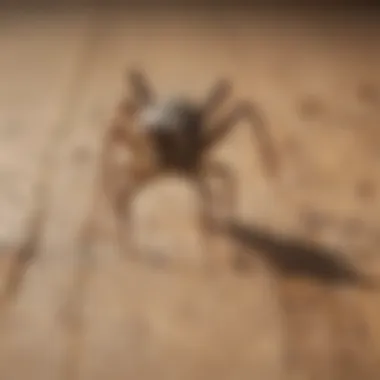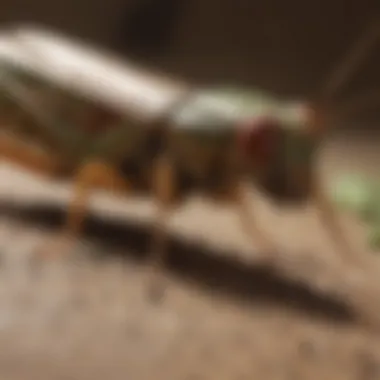Understanding and Managing Cricket Infestation in Homes


Intro
Cricket infestations can become a significant concern for homeowners. These pests are not only a nuisance, but they can also indicate larger issues within your home’s environment. Understanding how to identify, prevent, and manage these infestations ensures a comfortable living space. This article serves as a guide for both house owners and pest management professionals, aiming to equip readers with essential knowledge and tools to effectively address cricket issues.
Understanding Pests
Definition of Pests
Pests are organisms that cause harm or nuisance to humans, their properties, and their resources. In the case of crickets, the problem arises when they invade residential spaces, leading to a number of challenges for homeowners. They are not inherently harmful to health but can cause damage to property and produce noise that disrupts daily life.
Importance of Pest Identification
Proper identification is crucial in managing crickets. Understanding their characteristics — including their appearance, behavior, and life cycle — helps in determining the extent of an infestation and selecting the right control measures. Crickets can be identified by their long antennae, a cylindrical body, and their distinct chirping sounds. Familiarity with these traits aids in timely and effective management.
Prevention Techniques
Home and Garden Preventative Measures
Preventing cricket infestations starts with maintaining cleanliness in and around the home. Simple steps can be taken to mitigate the risk of crickets entering your space:
- Seal cracks and openings in windows and doors.
- Keep food in airtight containers.
- Regularly clear away debris and clutter in gardens.
- Maintain proper drainage to avoid water accumulation.
Seasonal Prevention Tips
Awareness of seasonal patterns can be beneficial. During warmer months, crickets are more active, leading to higher chances of infestation. Consider taking extra precautions during this time:
- Inspect for entry points before summer.
- Trim shrubs and grass regularly to deter crickets.
- Check for and remove any standing water outdoors, as it attracts them.
Eco-Friendly Pest Control Solutions
Overview of Sustainable Practices
There are numerous eco-friendly strategies that can be applied in cricket control. Using sustainable practices not only aims to eliminate pests but also ensures minimal harm to the environment. These practices include:
- Promoting biodiversity by introducing natural predators of crickets, such as birds and certain insect species.
- Using organic pest repellents made from natural ingredients.
Natural Remedies and Their Effectiveness
Natural remedies can be surprisingly effective against crickets. Some common options include:
- Diatomaceous Earth: This powdery substance can be sprinkled in areas where crickets are spotted. It works by damaging their exoskeletons and leading to dehydration.
- Essential Oils: Oils like peppermint and tea tree can repel crickets. Simply mix with water and spray in infested areas.
"Utilizing eco-friendly pest management not only solves the immediate problem but also bypasses further environmental risks."
By integrating these techniques, homeowners can maintain a comfortable living space while being mindful of the surrounding ecosystem.
Cricket infestations may be common, but understanding them is the first step toward effective management.
Prolusion to Cricket Infestation
Understanding cricket infestations is crucial for homeowners. These pests can quickly become a nuisance, often leading to discomfort in one’s living space. Crickets are not just annoying due to their incessant chirping; they represent a wider issue of pest management that every household should be aware of. Their presence usually indicates underlying problems such as structural vulnerabilities, inviting attention to both immediate and preventive measures.
Identifying the presence of crickets and understanding their behavior can lead to effective management strategies. This means recognizing not only what crickets are but also which types typically invade homes. Knowing these details allows homeowners to plan and implement targeted control methods, reducing reliance on chemical treatments and promoting eco-friendly approaches.


Housing sustainability and pest management go hand in hand. Homeowners can take significant steps to see that their living environment remains healthy and free from unwanted pests.
Understanding Crickets
Crickets belong to the Gryllidae family, with diverse species found globally. Their distinct chirping sound is a hallmark of their presence and a behavior primarily exhibited by males to attract females. Crickets thrive in warm and humid conditions, making homes and gardens ideal environments.
Their diet consists of various organic matter, including plants, fabrics, and wood. Thus, crickets can cause significant damage to household items if a large population establishes itself. Their lifecycle is relatively rapid, with females laying eggs that hatch into nymphs shortly after.
Homeowners need to become familiar with cricket behavior to determine the severity of an infestation and suitable intervention methods. Recognizing common practices, such as where they tend to congregate, facilitates more effective household management.
Common Types of House Crickets
Several types of crickets might take residence in homes, but a few are particularly common.
- Field Crickets: These are typically larger and can invade houses during warmer months in search of food and shelter. They are known for their darker coloration and distinctive chirping.
- House Crickets: Identifiable by their lighter color, these crickets are usually found in warm, damp spaces indoors. Their propensity to become household pests is due to their close association with human habitation.
- Treetop Crickets: Less common in homes, these crickets usually remain more outdoors but can venture inside during extreme weather.
Each type brings its specific preferences and challenges for control, emphasizing why understanding the common types is essential.
"Crickets may seem harmless, but their presence can signal larger issues within a home."
By identifying and understanding the types of crickets present, homeowners can better address infestations proactively and preserve their living environment.
The Ecological Role of Crickets
Understanding the ecological role of crickets is essential in managing cricket infestations in homes. Crickets are not just pests; they play significant roles in the ecosystem. They contribute to nutrient cycling, serve as a food source for various predators, and aid in soil aeration. Recognizing the multifaceted role of crickets helps in developing management strategies that balance ecological health with household comfort.
Crickets in the Ecosystem
Crickets belong to the Gryllidae family and are found in many environments, ranging from forests to suburban areas. They are omnivorous, feeding primarily on decaying plant matter. This dietary habit is pivotal for decomposition and nutrient recycling in the soil. By breaking down organic matter, crickets facilitate soil fertility, which supports plant growth. Additionally, crickets are prey for many creatures, including birds, reptiles, and small mammals, establishing them as a crucial component of food webs.
Crickets also contribute to soil aeration through their burrowing activities. This process enhances soil structure, leading to better water infiltration and root development. Without the presence of crickets, soil health could decline, affecting plant ecosystems significantly.
Benefits and Drawbacks of Crickets
Crickets have both benefits and drawbacks, especially when it comes to residential spaces. On the positive side, their role in decomposition is valuable for gardens and landscapes. They help maintain the balance of the ecosystem by acting as a natural fertilizer when they decompose. Additionally, their chirping sounds are considered part of nature's ambiance, adding a rural charm to outdoor spaces at night.
However, the disadvantages can outweigh these benefits when crickets invade homes. Their presence can be annoying due to their loud chirping, especially in the evenings. This noise is more than just an inconvenience; it can affect sleep quality. Furthermore, crickets can cause damage to household belongings by feeding on fabrics, papers, and even ornamental plants.
It's essential for homeowners to understand these aspects. While crickets can provide ecological benefits, managing their population is necessary when they become invasive. Proper control measures will enable households to enjoy the benefits of a balanced ecosystem without the disturbances that come from an overwhelming cricket presence.
"Understanding crickets' ecological roles informs better pest control practices, emphasizing the importance of managing infestations while preserving their ecological functions."
In summary, crickets hold an essential place in the environment. They promote healthy ecosystems but can turn into nuisances if left unmanaged. Recognizing both sides aids in effective cricket control and supports ecological balance.
Signs of Cricket Infestation
Recognizing the signs of a cricket infestation is crucial for timely management and control. Early detection is essential not only to alleviate the disturbances caused by these insects but also to prevent further invasion. Understanding how to identify various signs can save homeowners significant time and resources, while also maintaining a comfortable living environment. This section explores auditory cues, visual indicators, and common hiding places for crickets, which constitute the first steps in addressing an infestation.
Auditory Cues: Understanding the Chirping
The most distinctive sign of a cricket infestation is their chirping. Male crickets produce these sounds to attract females and establish territory. The pitch and frequency can vary among different species. For instance, the house cricket often emits a repetitive ‘chirp’ that can become quite bothersome during the nighttime hours.
To effectively gauge the level of infestation, consider the following points:


- Time of Day: Chirping is most common at night when crickets are active.
- Location: Identifying the direction from which the sound comes can help locate cricket hotspots within the home.
- Volume and Frequency: A higher volume or frequency may suggest a larger infestation.
In quiet environments, such as a home, the persistent noise can be strong motivation to take action. Homeowners should pay attention to these sounds as early evidence of the presence of crickets.
Visual Signs of Crickets in the Home
In addition to auditory cues, visual signs can indicate the presence of crickets. Observing actual insects is important as it confirms their existence within the home. Key visual signs include:
- Physical Presence: Spotting crickets during day or night, typically near light sources or in warmer areas.
- Droppings: Cricket feces appear as small black pellets, which can accumulate in corners or under furniture.
- Molted Exoskeletons: Crickets shed their skin as they grow, leaving behind exoskeletons that signify their growth cycle.
Finding these signs can indicate that crickets are not only present but may be breeding within the space. Regular inspections of potential hiding places can assist in early detection.
Common Hiding Places for Crickets
Crickets tend to favor dark, moist environments that provide ample hiding spots. Identifying these locations within a home is vital for thorough management. Common hiding spots typically include:
- Basements and Crawl Spaces: These areas often provide the humidity and darkness crickets thrive in.
- Behind Appliances: Spaces behind stoves and refrigerators can be breeding grounds due to warmth and food particles.
- Under Furniture: Sofas, beds, and cabinets often provide excellent shelter.
- Storage Boxes: Items in storage can harbor crickets, especially if they were exposed to the outdoors.
Greater awareness of cricket behaviors and tendencies can aid in their control. By knowing what to look for, homeowners can proactively address infestations, safeguarding their living spaces effectively.
Methods of Cricket Control
Controlling crickets in a home is essential to maintain comfort and hygiene. Understanding the methods of cricket control provides homeowners with the tools necessary to address an infestation effectively. The importance lies not only in eliminating the problem but in preventing future occurrences and ensuring a sustainable living environment. Each method offers unique elements and benefits, allowing for tailored approaches based on specific situations.
Preventive Measures for Cricket Infestations
The first line of defense against crickets is prevention. Homeowners can implement various strategies to make their surroundings less inviting for these insects. Some effective preventive measures include:
- Sealing Entry Points: Inspect windows, doors, and any cracks in walls. Use caulk or weather stripping to seal off these areas.
- Reducing Moisture: Crickets are attracted to damp areas. Fix any leaks in plumbing, and ensure proper ventilation in basements and attics.
- Proper Waste Management: Keep garbage bins covered. Regularly clean up food spills or crumbs to remove potential food sources for crickets.
- Landscaping Practices: Trim back tall grass and weeds around the home. This reduces hiding spots and minimizes the chances of crickets entering.
By implementing these steps, homeowners can significantly lessen the likelihood of a cricket infestation.
Traps and Baits for Crickets
If prevention fails, traps and baits become vital tools in managing crickets. These options are especially useful for monitoring and reducing cricket populations. The types of traps include:
- Sticky Traps: These traps utilize a sticky surface to capture crickets when they walk over. Place them near identified hiding spots.
- Homemade Traps: Create a simple trap using a bucket filled with water and a bit of soap. Lightly oil the rim to prevent escape. Place a bait of food on the edge to attract crickets.
Commercial baits are also available that contain attractants to draw in crickets. These methods allow for ongoing monitoring and can help in assessing the extent of the infestation.
Chemical Control: Pros and Cons
In some situations, chemical control methods may be necessary. It is important to weigh the pros and cons before proceeding:
Pros:
- Effectiveness: Chemical products can provide immediate results in reducing the cricket population.
- Range of Products: Various formulations are available, from sprays to baits, catering to different environments and needs.
Cons:
- Health Risks: Some chemicals can pose health risks to humans and pets if not applied carefully.
- Environmental Impact: Certain chemicals may harm beneficial insects and disrupt the local ecosystem.
Therefore, if using chemical control, it is vital to follow instructions carefully and consider the potential implications.


Natural and Eco-Friendly Solutions
For those seeking alternatives to chemical control, natural and eco-friendly solutions exist. These methods can be safe for both the environment and the inhabitants. Some popular options include:
- Essential Oils: Oils such as peppermint or tea tree can repel crickets. Dilute with water and spray around entry points.
- Diatomaceous Earth: This powdery substance can be sprinkled in areas where crickets frequent. It is safe but lethal to them by damaging their exoskeletons.
- Homemade Sprays: Combine vinegar with water or soap to deter crickets. Spray around potential entry points regularly.
These strategies can effectively manage cricket populations without the need for harsh chemicals, making them suitable for households focused on sustainability.
"Effective cricket control requires a multi-faceted approach that combines prevention, monitoring, and responsible use of available methods."
In summary, understanding and implementing methods of cricket control is crucial for maintaining a cricket-free home. The right combination of preventive measures, traps, and eco-friendly solutions can lead to effective management, allowing homeowners to reclaim their peace and comfort.
Implementing a Cricket Control Plan
Implementing a cricket control plan is crucial for homeowners facing cricket infestations. A comprehensive plan not only addresses the immediate presence of crickets but also seeks to prevent future occurrences. Strategies should be methodical, focusing on thorough assessment, targeted actions, and regular reviews.
Assessing the Extent of Infestation
To effectively manage cricket populations, it is important to start by assessing the extent of the infestation. This step involves closely examining both interior and exterior areas of the home. Homeowners should look for signs such as the chirping sound, droppings, or visible crickets in common areas.
- Check High-Risk Areas: Kitchens, basements, and attics are often breeding grounds for crickets due to moisture and food sources.
- Conduct Visual Inspections: Crickets are nocturnal, so conducting inspections during the evening can reveal their hiding spots.
- Take Note of Quantity: Count or estimate the number of crickets found. A small number may indicate a new problem, while a large number signals a more entrenched issue.
Using a combination of these methods will give homeowners a clearer picture of how severe the infestation is. This assessment is vital for tailoring effective control strategies.
Developing an Actionable Strategy
Once the extent of the infestation has been assessed, the next step is to develop an actionable strategy. The plan should incorporate various methods that are suitable for the specific situation.
- Identification of Entry Points: Analyze how crickets might be entering the home. Sealing cracks or gaps around doors and windows can reduce their access significantly.
- Combining Control Methods: Utilize both physical and chemical controls, as needed. For example, using traps in conjunction with eco-friendly insecticides can offer better results.
- Educate Household Members: Everyone in the home should be aware of the control measures being put in place. This includes understanding the importance of cleanliness in preventing return infestations.
An actionable strategy should be flexible, adapting to new information gathered from ongoing assessment processes.
Monitoring and Follow-Up Procedures
Implementing a cricket control plan does not end once the action steps are in place. Continuous monitoring and follow-up are essential to ensure that the control measures are effective.
- Regular Inspections: Set a schedule for regular checks after initial treatment. This will help to catch any new cricket activity early.
- Adjustment of Strategies: If crickets persist or return, revisit and adjust your strategy. This may include changing traps or re-evaluating sealants around the home.
- Recording Data: Keep records of findings, actions taken, and results observed. This data can be useful in understanding patterns of infestation and can inform future strategies.
Effective monitoring can significantly enhance the success of any pest control plan. Staying vigilant can prevent small problems from escalating into larger ones.
The End
In this article, we explored the complexities of cricket infestations within domestic environments. Understanding this aspect is vital for homeowners aiming to maintain their living spaces free from unwanted pests. Crickets, while having their ecological roles, can quickly become a nuisance when they invade homes.
Recap of Effective Management Practices
To mitigate cricket infestation, homeowners must focus on several effective management practices. Here are key strategies:
- Preventive Measures: Seal cracks and openings around windows and doors to limit cricket access. Keeping yards well-maintained helps by reducing hiding spots.
- Traps and Baits: Utilize sticky traps in areas where crickets are commonly found. These traps can effectively reduce adult populations.
- Chemical Control: If necessary, opt for insecticides designed for cricket control, ensuring to follow safety precautions.
- Natural Solutions: Consider using diatomaceous earth or essential oils like peppermint to deter crickets without harmful chemicals.
These strategies collectively form a robust approach toward managing cricket populations effectively. Regular upkeep and vigilance can prevent re-infestation.
Final Thoughts on Sustainable Cricket Control
Sustainable cricket control emphasizes the integration of eco-friendly practices with effective pest management. Homeowners should adopt methods that not only handle current infestations but also address root causes. Using non-toxic solutions reduces harm to both human health and the environment. Encouraging natural predators, like birds, can also be beneficial.
"Sustainable approaches often yield long-term benefits, preserving both the environment and your home’s comfort."
In summary, a thoughtful approach combining prevention, monitoring, and sustainable solutions is essential in dealing with cricket infestations. By applying the practices discussed, homeowners will be better equipped to maintain peaceful living spaces.



